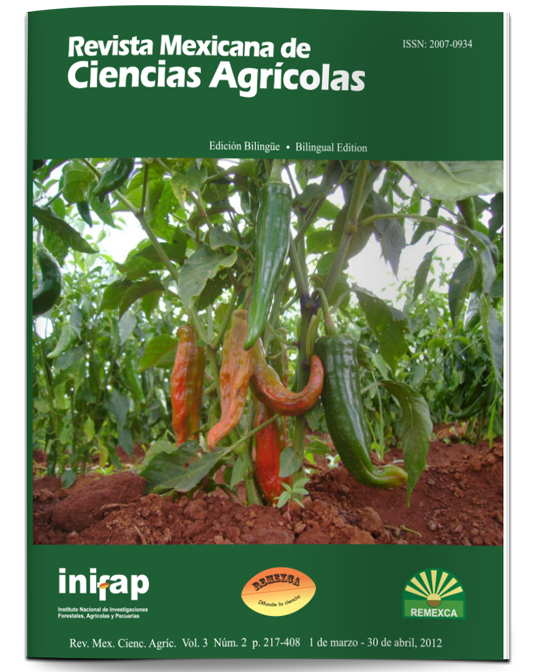Isolation of nitrogen-fixing and phosporus-solubilizing strains in alfisol soils of Venezuela
DOI:
https://doi.org/10.29312/remexca.v3i2.1463Keywords:
biofertilizers, fertility, sustainabilityAbstract
In order to evaluate the potential of soils in the Middle Valley of Yaracuy River in Venezuela for the production of biofertilizers, nitrogen fixed strains (FBN) and phosphorus- solubilizing strains (SF) were isolated in soils subjected to different management conditions. For this, rizhosferic samples in six different land uses were taken in April, 2010. Sugarcane (Sacharum officinarum), maize (Zea mayz L.), pawpaw (Carica papaya), grass (Brachiaria decumbens) and a forest area were sampled. Bacteria FNVL and SF were isolated using Ashby and Pikoskaya, respectively. Chemical and physical properties were evaluated in all soils to determine the relationship between them and the development of the strains. Results showed that Fn developed better in grass and sugarcane, with 20 and 10 strains respectively, indicating that FNVL strains developed better in uses with low amounts of organic matter or intensive management. The greatest number of SF bacteria was found in land uses with a higher amount of phosphorous (papaya), with 13 colonies, or in uses with adequate physical conditions for the growth of microorganisms (natural forest), with 10 colonies.
Downloads
Downloads
Published
How to Cite
Issue
Section
License
The authors who publish in Revista Mexicana de Ciencias Agrícolas accept the following conditions:
In accordance with copyright laws, Revista Mexicana de Ciencias Agrícolas recognizes and respects the authors’ moral right and ownership of property rights which will be transferred to the journal for dissemination in open access. Invariably, all the authors have to sign a letter of transfer of property rights and of originality of the article to Instituto Nacional de Investigaciones Forestales, Agrícolas y Pecuarias (INIFAP) [National Institute of Forestry, Agricultural and Livestock Research]. The author(s) must pay a fee for the reception of articles before proceeding to editorial review.
All the texts published by Revista Mexicana de Ciencias Agrícolas —with no exception— are distributed under a Creative Commons License Attribution-NonCommercial 4.0 International (CC BY-NC 4.0), which allows third parties to use the publication as long as the work’s authorship and its first publication in this journal are mentioned.
The author(s) can enter into independent and additional contractual agreements for the nonexclusive distribution of the version of the article published in Revista Mexicana de Ciencias Agrícolas (for example include it into an institutional repository or publish it in a book) as long as it is clearly and explicitly indicated that the work was published for the first time in Revista Mexicana de Ciencias Agrícolas.
For all the above, the authors shall send the Letter-transfer of Property Rights for the first publication duly filled in and signed by the author(s). This form must be sent as a PDF file to: revista_atm@yahoo.com.mx; cienciasagricola@inifap.gob.mx; remexca2017@gmail.
This work is licensed under a Creative Commons Attribution-Noncommercial 4.0 International license.



